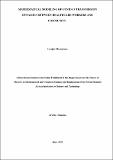| dc.description.abstract | COVID-19 pandemic has posed an unprecedented threat to global public health. Health profes sionals caring for COVID-19 patients face insomnia, mental stress, physical exhaustion, stigma,
the pain of losing patients and colleagues. Many of them acquired SARS-CoV-2 and some died.
Protection of this workforce is of paramount importance to ensure optimal care to patients. Thus,
this study contributes to the subject by formulating a deterministic mathematical model SW E
IsIaHR (Susceptible - Healthcare workers - Exposed - Symptomatic - Asymptomatic - Hospi talized - Recovered) that combines both healthcare workers (as an independent compartment)
and community and focuses on the protection of the healthcare workforce against SARS-COV-2.
Benefiting the next generation matrix method, the basic reproduction number (R0) was computed.
Routh-Hurwitz criterion and stable Metzler matrix theory revealed that disease-free equilibrium
point is locally and globally asymptotically stable whenever R0 < 1, respectively. Lyapunov func tion depicted that the endemic equilibrium point is globally asymptotically stable when R0 > 1.
Further, the dynamics behavior of R0 was explored when varying the use personal protective
equipment (ξ) and physical distancing (θ). In the absence of protective measures (ξ and θ), the
value of R0 was 6.7125 which implies the expansion of the disease. When θ and ξ were introduced
in the model, R0 was 0.6713, indicating the decrease of the disease in the community. Numer ical solutions were simulated by using Runge-Kutta fourth-order method. The numerical results
illustrated mathematically that protection of health care workers can be achieved through effec tive use of personal protective equipment and minimization of transmission of COVID-19 in the
community. | en_US |

